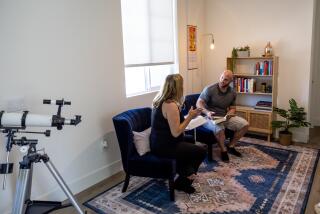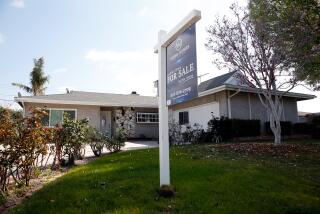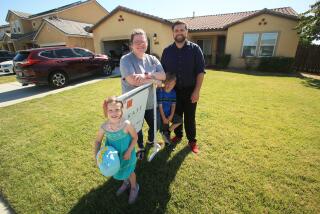Recovery Is People Buying Homes Again
- Share via
Be it ever so humble, there’s no place like home--and nothing so encouraging for the economy as a pickup in home sales.
Which explains the spreading optimism as reports come in of rising home-buying activity in all parts of the country. In the stricken Northeast, New Jersey’s Hovnanian Enterprises sold out two townhouse developments--in the $130,000 price range--before construction began. In the Southeast and Midwest, buyer interest is returning. And Texas and the Southwest, which were depressed for most of the 1980s, now boast some of the nation’s healthiest housing markets.
In Southern California, first-time buyers are increasingly active, helped by FHA-insured mortgage limits as high as $126,000. Inco Homes is selling starter houses--$80,000 and up--in Adelanto, near Victorville, and Kaufman & Broad is doing likewise in the Antelope Valley.
Nationally, first-time buyers, on average, now have 81% of the income needed to support a mortgage on a typical starter home, according to the National Assn. of Realtors--the highest affordability level in five years for beginning homeowners. And overall affordability is at its highest level since the mid-1970s--meaning that more Americans can qualify for mortgages on more houses than at any time in the last 14 years.
It’s the bright side of last year’s nationwide decline in the prices of existing homes. Potential buyers are attracted by lower house prices and falling mortgage interest rates--close to 9% and going lower if necessary to spur the economy, says Federal Reserve Board Chairman Alan Greenspan. Consumer confidence is up since the end of the Gulf War, so buyers are out these early-spring weekends. That’s good news for the economy because housing is a great engine, leading to purchases of furniture and carpets, pictures and wallpaper, pots and pans.
And it’s even more encouraging news for the future because this housing recovery wasn’t supposed to happen, according to numerous experts. Fear and foreboding have been in fashion in recent years. Studies based on population trends have predicted that the nation would need less housing from now on because growth in the number of young people now doesn’t compare to the baby boom generations--the 70 million Americans born between the late 1940s and early 1960s. That means that consumer spending will dry up and home prices collapse, said analyses put forth by major universities, economic consultants and Wall Street brokerage firms.
But for the most part these analyses are hogwash. They mistakenly assume that population trends alone govern the economy. In reality, economic factors such as interest rates, consumer confidence and employment mainly determine economic trends. There are many baby boomers who still would like to buy their first home and many young people who have been kept out of the market by ballooning house prices.
Now things are changing. In the last year or so, home prices have fallen 10% to 20% in many parts of the country, and that price cut plus renewed confidence has spurred home-buyer interest. So real estate is snapping back even a little ahead of the general economy.
And home buying may continue to rise in response to pent-up demand. Fact is, home ownership has just begun to increase after more than a decade of decline. The Center for Housing Studies at Harvard University reports that ownership among 30- to 34-year-olds increased slightly in 1989 to 53.6% of that group. It was the first upturn after a long decline from the peak in 1976, when 62.4% of that group owned their own home.
Put that in perspective: Through all of U.S. history prior to 1940, 45% of Americans owned their homes, says Denise di Pasquale of the Harvard Housing Center. The decades after World War II took ownership to new heights--because of healthy economic growth with low inflation.
But then, in the late 1970s and early ‘80s, raging inflation, rising interest rates and other economic troubles combined to lower home ownership. Now, with inflation subsiding and interest rates declining, there’s at least hope that a healthier pattern could be resuming.
To be sure, smart folks are keeping their powder dry. “Real estate in California is spotty; the recovery is no great shakes yet,” says Edward Abbott of Western Pacific Capital, a San Francisco investment company. Still, recent sales reports have to be encouraging. As well as signaling that renewed economic growth may be imminent, they testify that people’s desire to own a home is undiminished.
That should give government policy-makers and private lenders something to think about, says Don Butler of Butler Homes in West Memphis, Ark., who builds $40,000 starter homes. Butler complains that these days banks are coming down hardest on first-time buyers, contending that the small borrower is the greater credit risk. Government too is making life hard for the little guy by adding new regulations on FHA loans.
In previous decades, the country understood that a healthy economy is built from the bottom up. At the end of World War II, William Levitt & Sons of Levittown, Long Island, built affordable homes for returning veterans, and government chipped in with mortgage programs. And that led to the greatest boom in housing and economic well-being that any nation ever saw.
If government and finance would remember that and encourage the first-time home buyer, the ripple effect could swell the whole economy.
More to Read
Inside the business of entertainment
The Wide Shot brings you news, analysis and insights on everything from streaming wars to production — and what it all means for the future.
You may occasionally receive promotional content from the Los Angeles Times.










